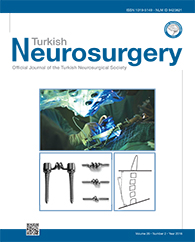*Tielong LIU, Jinhai KONG, Weiwei ZOU equally contributed to this study and should be considered as first authors DOI : 10.5137/1019-5149.JTN.7476-12.1 AIM: To compare both the clinical characteristics and incidence of postoperative cervical nerve root palsy in cervical spondylosis patients treated by posterior total laminectomy, decompression and instrumentation with two different common body positions, traction bed and plaster bed.
MATERIAL and METHODS: One hundred and thirty-three patients, with a mean age of 49.5 years suffering from multilevel cervical spondylosis and treated by laminectomy from 2007 to 2009, were reviewed.
RESULTS: Overall 30 of 133 (22.56%) patients had C5 palsy, of which 14 (19.44%) out of 72 patients were in the plaster bed group, while 16 of 61 (26.23%) patients were in the traction bed group. The difference was statistically significant (P <0.05).
CONCLUSION: The cervical curvature index (CCI) reflected both the change of cervical height and the change of the overall cervical curvature. CCI was related with the incidence of C5 nerve root palsy postoperatively. The patients in the traction bed group had a higher nerve root palsy rate and change in cervical alignment because of over traction.
Keywords : Cervical spondylosis, Laminectomy, Surgical complication, Postoperative C5 palsy, Spinal instrumentation




